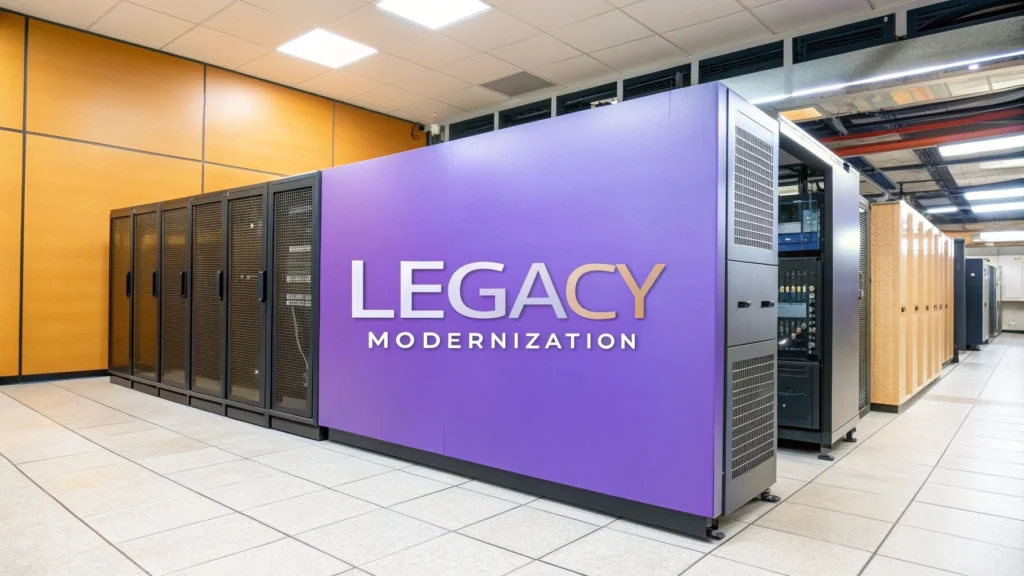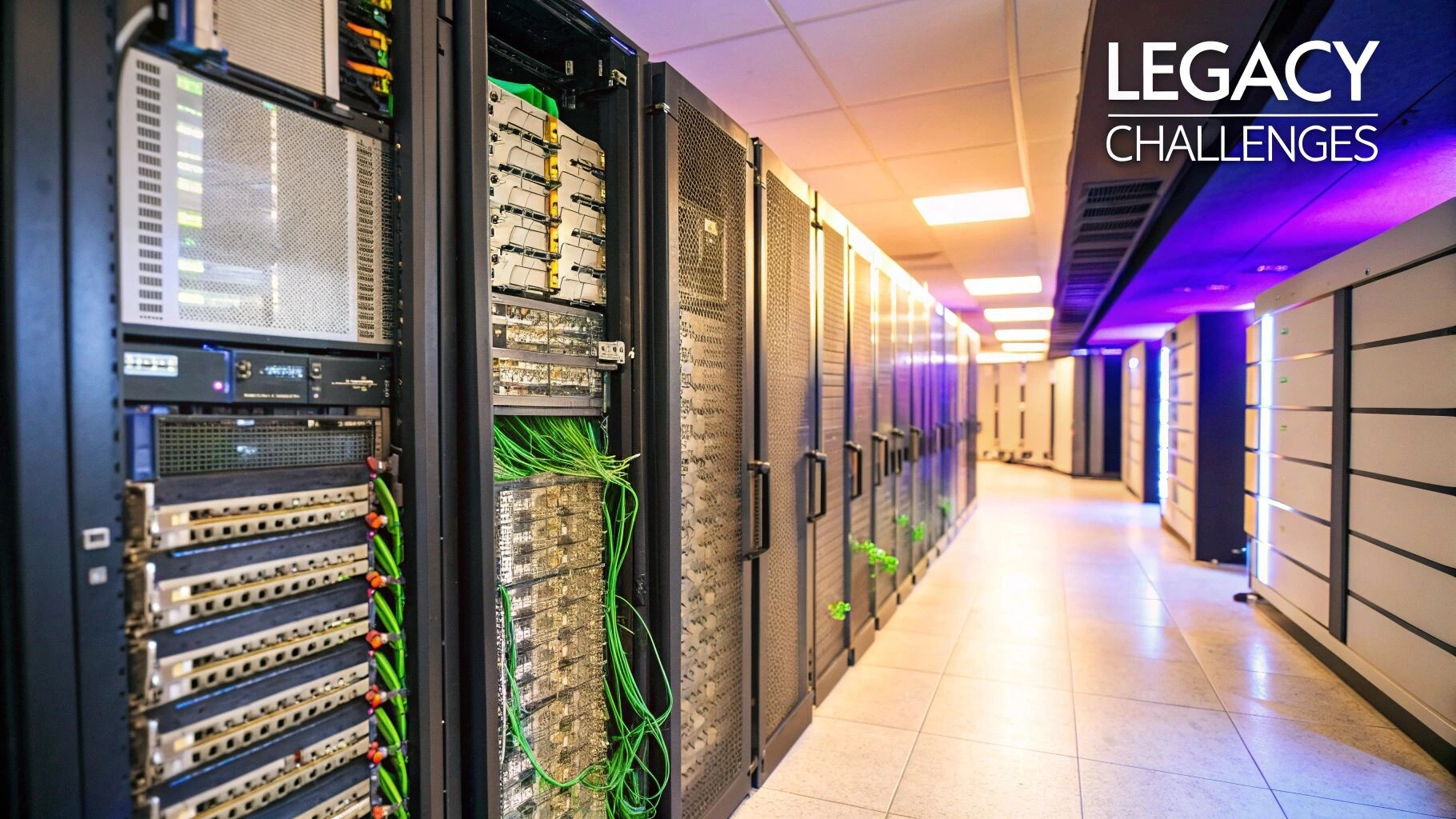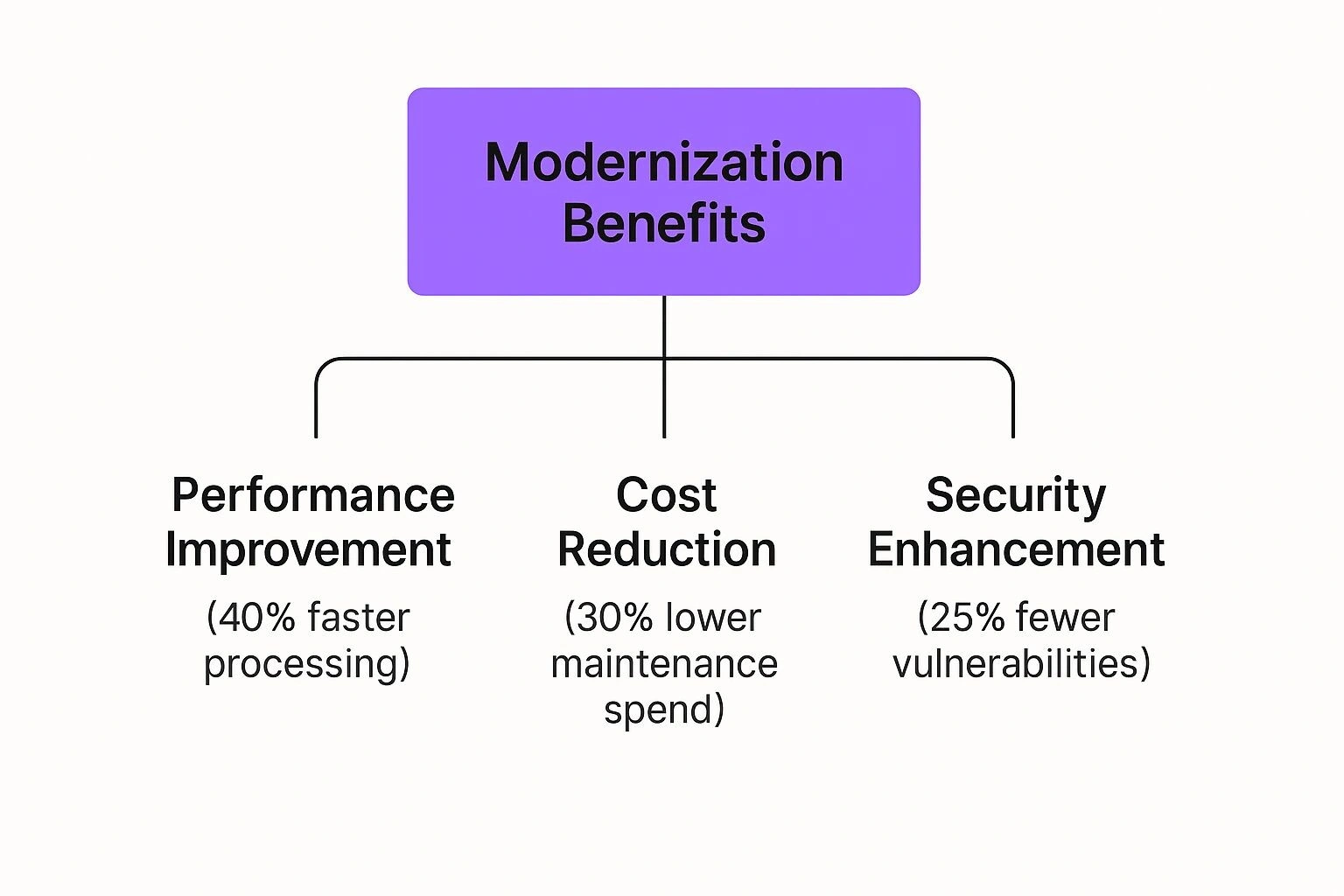Legacy System Modernisation: Your Strategic Guide
Discover top strategies for legacy system modernisation in Australia. Avoid risks and build a future-proof IT infrastructure today.

Picture your company’s core IT system. Is it like a trusty old ute? It’s been reliable for years, hauled a heavy load, and never let you down. But now, it’s starting to show its age. It guzzles resources, lacks the safety features you need in today’s world, and can’t keep up with the pace on the business motorway.
Legacy system modernisation isn’t just a tech refresh. It’s the strategic decision to overhaul that old ute, turning it into a high-performance vehicle built for today’s demands. It’s about boosting efficiency, shoring up security, and giving you the power to pull ahead of the competition.
Why Modernisation Is a Business Imperative
At its heart, legacy system modernisation is the process of updating or replacing outdated IT infrastructure, software, and the processes that rely on them. This is far more than simply installing the latest software; it’s a fundamental rethink of how technology actually serves your business objectives. For countless Australian businesses, these older systems have gone from being assets to anchors, holding back growth and agility.
Sticking with these systems is like trying to run a modern e-commerce business using a fax machine and a paper ledger. It inevitably creates operational bottlenecks, opens you up to serious risks, and makes it nearly impossible to respond to shifts in the market. The goal is to shift from a reactive, maintenance-heavy IT model to one that is proactive, drives value, and actively fuels innovation.
The True Cost of Inaction
Putting off modernisation isn’t a cost-saving tactic; it’s more like accumulating technical debt with compounding interest. Outdated systems demand specialised, and often scarce, skills for maintenance, which inflates your operational costs year after year. Worse still, they become significant security weak spots, especially if they no longer receive critical security updates, leaving your valuable data dangerously exposed.
The real risk isn’t the cost of modernising. It’s the spiralling expenses and mounting vulnerabilities that come from standing still. Inaction leaves a business defenceless against security threats, bogged down by inefficiency, and at risk of becoming irrelevant.
This isn’t just a hypothetical concern. The market is reacting to this urgency. Projections show the Australian industry vertical modernisation services market is set to grow from around USD 13.79 million in 2023 to USD 42.04 million by 2032. This isn’t a slow creep; it’s a clear signal that local businesses are actively investing to escape these technological dead ends. For a deeper dive, you can explore this detailed legacy modernization market analysis.
Key Drivers for Change
The push to modernise is rarely just an IT project. It’s a response to clear and pressing business needs that stretch across the entire organisation. To make sense of the investment, you need to understand the powerful business and technical drivers compelling companies to act.
The table below summarises the key reasons why organisations decide it’s time for a change. These drivers highlight how modernisation moves a company from simply ‘keeping the lights on’ to building a platform for future growth.
Key Drivers for Modernising Legacy Systems
| Business Driver | Description |
|---|---|
| High Maintenance Costs | Outdated systems require specialised talent and frequent repairs, leading to escalating operational expenses that drain the IT budget. |
| Security Vulnerabilities | Older software often lacks modern security protocols and may no longer receive vendor support or patches, creating easy targets for cyberattacks. |
| Lack of Business Agility | Rigid, monolithic systems make it slow and difficult to launch new products, integrate with partners, or adapt to market changes. |
| Integration Challenges | These systems are notoriously difficult to connect with modern SaaS platforms, APIs, and cloud services, resulting in data silos and inefficient workflows. |
| Compliance Risks | Meeting modern regulatory standards like GDPR or Australian privacy laws can be nearly impossible on systems not designed for today’s data governance needs. |
| Poor Customer Experience | Slow performance, frequent downtime, and a lack of modern features directly impact customer satisfaction and can drive them to competitors. |
| Scarcity of Skills | The pool of developers and engineers with skills in obsolete programming languages (like COBOL or Fortran) is shrinking, making support both expensive and risky. |
Ultimately, these drivers point to a single conclusion: the status quo is unsustainable. To build a resilient and competitive business, you need technology that enables, rather than inhibits, your strategic goals.
The Strategic Pay-Off
Getting this right delivers benefits that ripple through every part of the business. You can unlock a wide range of benefits of cloud migration, which often forms a core part of the journey. Of course, the path you take matters, which is why understanding the different legacy system modernisation strategies is such a critical first step.
The primary motivators for this change include:
- Enhanced Business Agility: Modern systems let you pivot quickly. You can launch new services faster and adapt to changing customer expectations without being handcuffed by old, inflexible technology.
- Improved Operational Efficiency: Automating manual tasks and integrating disconnected systems cuts down on errors. It frees your people to focus on higher-value work and smooths out workflows right across the organisation.
- Strengthened Security and Compliance: New platforms are built with robust, current security features. This makes it far easier to comply with evolving data protection regulations like the GDPR and local privacy acts.
The Hidden Costs of Outdated Systems
Hanging onto outdated technology isn’t just an inconvenience; for many Australian organisations, it’s a very real and growing liability. The obvious expense of keeping old systems alive is often just the tip of the iceberg. Underneath the surface, there are deeper, more damaging costs that are quietly crippling growth, innovation, and security. Seeing these red flags is the first step toward making a solid business case for change.

Think of a legacy system’s budget like a bucket with a slow leak. At first, you can probably manage the water loss. But over time, that leak gets bigger. Soon, you’re spending all your time and effort just refilling the bucket, with nothing left over for anything else. This is exactly what happens when doing nothing becomes the default plan.
The Spiralling Maintenance Drain
The most immediate pain point is the ever-increasing cost of just keeping the lights on. Older systems, often pieced together with archaic code and clunky infrastructure, need a very specific, and shrinking, pool of talent to manage them. As these experts retire, their skills become rare and incredibly expensive, which inevitably drives up your operating costs.
This kicks off a vicious cycle. Your budget gets eaten up by maintenance demands, which then starves other critical parts of the business. It’s a huge problem in the public sector. For instance, some Australian government agencies now spend around 80% of their technology budgets simply maintaining outdated systems. This figure screams for a shift in thinking, from just propping up old tech to investing in modern, agile platforms. You can get a better sense of these public sector struggles in this report on the push to modernise legacy systems.
When maintenance is eating up most of your IT budget, you’re not investing in the future; you’re just paying a tax on the past. This financial drain directly hobbles your ability to innovate and compete.
This constant financial squeeze means there’s little, if any, money left for developing new features, improving the customer experience, or chasing new opportunities. The business is essentially stuck in neutral, held back by the very systems that are supposed to support it.
Critical Security and Compliance Gaps
Beyond the financial drain, outdated systems are a massive security risk. Legacy software often stops getting security patches from its vendor, leaving it wide open to modern cyber threats. Think of these unpatched vulnerabilities as unlocked doors for hackers, putting your sensitive company and customer data in the firing line.
The fallout from a breach can be catastrophic, leading to:
- Financial Loss: Fines from regulatory bodies, legal fees, and remediation costs can pile up quickly.
- Reputational Damage: Losing customer trust is incredibly hard to win back and can cause a mass exodus of clients.
- Operational Disruption: A major security incident can bring your entire operation to a standstill for days or even weeks.
On top of this, these old systems often can’t keep up with today’s regulatory standards. Trying to comply with ever-changing data privacy laws becomes a messy and often manual task, raising the risk of expensive penalties for non-compliance. This turns legacy system modernisation from a simple tech upgrade into a vital governance and risk management exercise.
Doing nothing is still a decision, and it comes with its own set of consequences. The cost of delay, measured in lost opportunities, escalating security risks, and ballooning maintenance bills, will almost always eclipse the investment needed for modernisation.
Choosing Your Modernisation Strategy
Kicking off a legacy system modernisation project isn’t a case of picking a solution off a shelf. There’s no single “right” way to do it. The best path for your business hinges entirely on your specific goals, the budget you’re working with, your existing tech, and how much change your organisation can handle at once.
You wouldn’t use a sledgehammer to fix a watch, and the same logic applies here. Picking the right strategy is the most critical decision you’ll make. The industry often talks about the ‘7 Rs’ of migration. While the names sound technical, they simply represent a spectrum of choices, each with a different balance of cost, risk, and long-term benefit.
This is where the real work begins, analysing the trade-offs to find the approach that delivers the most value. This infographic gives a great high-level view of what businesses are trying to achieve with these projects.

As you can see, the data backs up the effort. Done right, modernisation delivers real, measurable gains in performance, cost savings, and security, which is why so many organisations are making the investment.
The Low-Risk Starting Points
For many, a complete, ground-up overhaul is just too disruptive or expensive to tackle in one go. Thankfully, you don’t have to. Several strategies offer a much gentler entry point, focusing on getting more out of what you already have with minimal code changes.
-
Rehost (Lift and Shift): This is the most straightforward approach. Imagine moving your entire office to a new, better building but keeping all your old furniture and equipment. You’re simply redeploying your application to a new home, usually the cloud, without touching its core architecture. It’s fast and relatively cheap, but it won’t fix any of the application’s underlying problems.
-
Replatform (Lift and Reshape): This is a small step up from rehosting. It involves making a few smart tweaks to your application so it can take better advantage of its new environment. For instance, you might migrate to a managed database service to cut down on admin headaches. You get more cloud-native benefits than a simple rehost, but without the cost and complexity of a major rewrite.
The Transformative Approaches
When the goal is to fundamentally change what an application can do, you need to be more ambitious. These strategies require a bigger investment of time and money, but the payoff in long-term value is significantly greater.
It’s a classic mistake to frame modernisation purely as an IT cost. The most successful projects are treated as a strategic business investment, with clear goals tied to agility, customer experience, or competitive advantage.
Consider these more powerful options:
-
Refactor: This strategy is all about improving the inside without changing the outside. You restructure and clean up existing code to boost performance or make it easier to maintain, but the application’s functionality remains the same to the end-user. Think of it like rewiring an old house to meet modern safety codes while keeping the floor plan identical. It’s a fantastic way to pay down technical debt.
-
Rearchitect: Here, you’re making significant changes to the application’s very foundation. A common example is breaking down a clunky, monolithic application into a set of nimble microservices. This approach can unlock huge gains in scalability and agility, but make no mistake, it’s a complex, high-effort undertaking.
The Full Overhaul Strategies
Sometimes, an application is simply too old, too fragile, or too broken to be worth saving. In these situations, starting fresh is the only sensible move. It’s the highest-effort path, but it also offers the greatest potential for a truly modern outcome.
-
Rebuild: This means writing the application from the ground up, but keeping its original purpose and specifications. You’re building a brand-new, modern version that does the exact same job as the old one, just far better.
-
Replace: With this strategy, you pull the plug on the old application entirely and switch to a completely different solution. This often involves adopting a commercial-off-the-shelf (COTS) or Software as a Service (SaaS) product that already does what you need. It’s a pragmatic choice when a great third-party solution is already out there.
Comparing Modernisation Strategies
To help you visualise these trade-offs, we’ve put together a simple comparison. Each strategy has its place, and understanding where they fit is key to making an informed decision that aligns with your business’s risk tolerance and strategic goals.
| Strategy | Relative Cost | Relative Risk | Best For |
|---|---|---|---|
| Rehost | Low | Low | Quick cloud migration, archiving, or when no code changes are possible. |
| Replatform | Low-Medium | Low | Gaining cloud benefits (e.g., managed services) with minimal code changes. |
| Refactor | Medium | Medium | Improving code quality, reducing technical debt, and preparing for future changes. |
| Rearchitect | High | High | Shifting to a more scalable architecture like microservices for long-term agility. |
| Rebuild | Very High | High | When the core function is still needed but the existing codebase is unsalvageable. |
| Replace | Variable | Medium | When a SaaS or commercial product can meet business needs better than a custom app. |
Ultimately, choosing the right path forward means taking a hard look at your operational needs and your vision for the future. The goal isn’t just to fix today’s problems but to build a stronger foundation for whatever comes next.
For a deeper dive into these choices, you can read our complete guide on developing a legacy system migration strategy.
How AI Is Reshaping Modernisation
It’s a classic chicken-and-egg scenario: Artificial Intelligence (AI) and legacy system modernisation. They have a powerful, symbiotic relationship. AI isn’t just a compelling reason to finally overhaul your old systems; it’s also a formidable tool that can make the entire modernisation journey faster, smarter, and far less risky.
For Australian businesses, this intersection isn’t just a talking point, it’s a critical juncture where taking action will define future competitiveness.

On one side of the coin, AI’s insatiable appetite for data makes modernisation an absolute necessity. Your legacy systems, with their rigid data silos and clunky structures, simply can’t feed the beast. They can’t supply the high-volume, often unstructured, and real-time data that modern AI applications depend on. Failing to build an AI-ready foundation is no longer just a missed opportunity; it’s a direct threat to your ability to stay in the game.
AI as the Catalyst for Change
Across the Asia-Pacific region, including right here in Australia, the year 2025 is shaping up to be a pivotal deadline. There’s a palpable urgency to overhaul outdated IT infrastructure, and it’s being driven almost entirely by the disruptive force of AI. Analysts predict that by 2025, about 30% of APAC enterprises will have the right people, processes, and platforms in place for a full-scale legacy modernisation. You can read more about why 2025 is a critical year for legacy modernisation to grasp the full picture.
This compressed timeline is a direct response to AI’s demands. Old-school tech like relational databases just can’t keep up. Ignoring this shift means potentially missing out on a market expected to hit USD 631 billion by 2028. It truly is a ‘now or never’ moment to modernise or risk being left behind.
AI as a Modernisation Accelerator
Thankfully, AI isn’t just creating the problem, it also offers a powerful part of the solution. Legacy system modernisation no longer has to be a purely manual, high-risk, and resource-draining slog. It can now be augmented and accelerated with intelligent tools. AI’s ability to chew through vast amounts of complex information makes it the perfect partner for untangling decades of accumulated technological debt.
AI fundamentally shifts modernisation from a purely human-led effort to a human-supervised one. It automates the tedious and error-prone tasks, freeing up your expert teams to focus on what matters most: strategic architecture and business value.
Here’s how AI is already helping organisations de-risk and speed up their projects:
-
Automated Code Analysis and Translation: Imagine AI tools scanning millions of lines of archaic code like COBOL or Fortran. They can identify dependencies, map out the underlying business logic, and even help automate the translation into modern languages like Java or Python. This dramatically cuts down the time and human error involved in a rebuild.
-
Intelligent Testing and Validation: Testing is one of the biggest bottlenecks in any migration. AI can automate the creation and execution of thousands of test cases, meticulously comparing the new system’s output against the old to ensure everything works as it should. It spots bugs far faster than any manual team ever could.
-
System Architecture Discovery: AI can analyse a legacy system’s tangled architecture and spit out clean, detailed documentation and dependency maps. This gives architects a clear blueprint of what they’re dealing with, which is vital for planning a phased migration and spotting hidden complexities before they become major roadblocks.
By weaving AI into the modernisation process itself, organisations can confidently tackle projects that were once considered too complex, too costly, or simply too risky. To get started, have a look at some practical advice on the initial steps for AI integration. It’s a pragmatic way to turn a daunting challenge into a manageable, high-value strategic initiative.
Building Your Modernisation Roadmap
Attempting a legacy system modernisation without a solid roadmap is like trying to navigate the Outback without a map or compass. You might be moving, but you’re almost certainly not heading in the right direction. A well-structured plan is what separates a successful, value-driven transformation from an expensive project that ultimately fails to deliver.
This roadmap provides a clear, actionable framework that breaks the entire process into manageable phases. It turns an overwhelming challenge into a sequence of deliberate, strategic steps, giving you the confidence to lead the change.
Phase 1: Initial Assessment and Discovery
Before you can even think about planning the journey, you have to know exactly where you’re starting from. This initial phase is all about deep analysis and an honest evaluation of your current state. It isn’t enough to simply label a system as “old”; you need to understand precisely how it functions, where its weaknesses lie, and what value, if any, it still provides.
This discovery process has to be thorough. The goal is to create a complete, unvarnished picture of your IT landscape. One of the most common reasons these projects fail is an incomplete assessment, which almost always leads to nasty surprises and budget blowouts down the line. In fact, a staggering up to 74% of organisations that start a modernisation journey fail to complete it, often because of poor initial planning.
Key activities in this phase include:
- System Auditing: Documenting the current architecture, all the technologies in play, code dependencies, and data structures.
- Business Process Mapping: Identifying exactly which business functions rely on the legacy system and mapping out how they operate.
- Stakeholder Interviews: Talking to the people on the ground, users, managers, and IT support staff, to understand their daily pain points and any hidden workarounds they’ve created.
Phase 2: Building the Business Case
With your assessment complete, the next logical step is to translate those technical findings into a compelling business case. This is where you connect the dots between the technology problems and tangible business outcomes. A strong business case moves the conversation away from being an IT cost and reframes it as a strategic business investment.
You must be able to clearly articulate the “why” behind the project. Frame your argument around the drivers that resonate most with executive leadership, like reducing operational costs, mitigating critical security risks, or unlocking new revenue streams.
A modernisation roadmap is more than a project plan; it’s a strategic narrative. It must clearly articulate the current pain, the future vision, and the logical steps needed to bridge the gap between them, ensuring everyone from the board room to the development team is aligned.
This narrative needs to be backed up with hard data. Use the metrics gathered during your assessment to quantify the cost of doing nothing, think annual maintenance spend, hours lost to manual processes, or customer churn. This makes the return on investment (ROI) crystal clear and justifies the budget and resources you’re asking for.
Phase 3: Strategy Selection and Phased Rollout
Now you’re ready to choose the right modernisation approach. Using your business case and system assessment as a guide, select the strategy that best aligns with your goals, whether it’s a simple Rehost, a more involved Refactor, or a complete ground-up Replacement.
Crucially, you must plan for a phased rollout. A “big bang” migration, where you try to switch everything over at once, is incredibly risky and practically invites business disruption. A gradual, piece-by-piece approach is far safer and starts delivering value much sooner.
This is often referred to as the “Strangler Fig” pattern. New services are built around the old system, gradually taking over its functions until the legacy application can be safely and quietly retired. This method has several powerful advantages:
- Minimises Business Disruption: Core operations can continue uninterrupted while new components are developed and tested in parallel.
- Delivers Early Wins: Rolling out smaller pieces of functionality provides tangible value to the business early on, which builds momentum and stakeholder confidence.
- Reduces Project Risk: It’s far easier to manage and de-risk smaller, incremental changes than one massive, complex cutover.
- Enables Learning: Your team can learn and adapt as the project progresses, applying lessons from the early phases to the later ones.
This step-by-step implementation is also vital for integrating new and old systems during the transition. For a comprehensive look at how this works, you can explore the essential system integration steps that ensure a smooth process. By breaking the project into manageable chunks, you transform a daunting overhaul into a series of achievable milestones.
Australian Modernisation Success Stories
Theory and roadmaps are one thing, but nothing tells the story of legacy system modernisation quite like real-world examples. Seeing how other Australian organisations have walked this path, and succeeded, provides a far more compelling blueprint than any abstract framework. These stories are proof that even the most deeply embedded, outdated systems can be transformed with the right strategy.

Let’s look at a couple of anonymised examples from key Australian sectors. Each one highlights a different kind of problem, a distinct strategic response, and the very real business outcomes that followed.
A National Retailer Reinvents Its Customer Experience
Imagine a household-name Australian retail chain still running on an e-commerce platform from the early 2000s. It was slow, constantly crashed during peak sales like Boxing Day, and adding a simple feature like a new payment option was a months-long coding ordeal. Their digital presence was becoming a liability, bleeding online revenue to more nimble competitors.
Rather than attempting a risky, all-at-once replacement, they chose a gradual Rearchitect strategy, guided by the Strangler Fig pattern.
- First Move: They pinpointed the biggest customer pain point, the checkout and payment process. A brand new, stand-alone microservice was built just for this function and carefully integrated to handle all checkout traffic, while the old system continued to run everything else.
- Systematic Progress: Over the next 18 months, they continued this process, methodically carving out other pieces of the old system. Product search, inventory management, and customer accounts were all rebuilt as separate, cloud-native services.
- The Payoff: Eventually, the original monolith had nothing left to do and was simply switched off. The retailer’s reward was a 40% jump in online conversion rates, page load times were cut in half, and the team could now roll out new features in days instead of months.
A Financial Services Firm Overcomes a Data Crisis
A mid-sized wealth management firm was completely reliant on a mainframe system from the 1990s. It was a workhorse, to be sure, but getting data out for modern analytics or regulatory reporting was a nightmare of slow, manual processes. Regulators were losing patience, and the firm couldn’t deliver the sophisticated, data-backed insights their clients expected.
The greatest challenge wasn’t just replacing old technology, but safely migrating decades of highly sensitive financial data without disrupting daily operations or compromising security.
Their approach was a smart mix of Replatforming the core system and Replacing the analytics tools. First, they moved their main transaction database to a managed cloud database service, which gave them an immediate performance boost and slashed their infrastructure costs. At the same time, they ditched their clunky, old reporting tools for a modern, cloud-based business intelligence (BI) platform.
The impact was profound. Report generation times dropped from weeks to mere hours. Key compliance checks became automated. And most importantly, financial advisors gained real-time access to client portfolio data. This project didn’t just fix their data problem; it built the foundation they needed to develop future AI-driven advisory services.
Answering Your Legacy Modernisation Questions
Even with the best strategy laid out, it’s only natural to have practical questions before diving into a legacy modernisation project. Business leaders often ask about the same core concerns, timelines, risks, and day-to-day operations. Here are some straightforward answers to the most common queries we hear.
How Long Does This Actually Take?
There’s no single answer here. The timeline for modernising a legacy system really depends on its size, how tangled its code is, and which approach you take.
A simple Rehost, often called a “lift and shift,” could be done in just a few months. You’re essentially moving the application to the cloud without touching the code. On the other hand, a complete Rebuild of a core business system from the ground up could easily stretch to 18 or 24 months, sometimes even longer. The real secret is to avoid a single, high-stakes “big bang” launch.
A phased rollout is your best friend. This approach lets you deliver tangible value to the business in stages. It’s a smarter way to manage risk, build momentum, and show a return on your investment long before the project is fully complete.
What’s the Single Biggest Mistake We Could Make?
The most common and expensive pitfall is treating modernisation as a purely technical exercise. It’s not. This is a business transformation initiative, and it needs to be treated that way. Success absolutely depends on having strong executive buy-in, clear business goals, and a solid plan for managing the change.
If you don’t get your business teams deeply involved from day one, you’re on a fast track to building a system that’s technically perfect but completely misses the mark on what users actually need. Another classic mistake is a shallow initial assessment. Skimming over the complexities of the old system almost always leads to nasty surprises, delays, and blown budgets down the line.
Can We Do This Without Shutting Everything Down?
Yes, you certainly can. In fact, keeping the lights on is a non-negotiable goal for any modern approach. A number of well-established techniques are designed specifically to ensure your business keeps running smoothly during the transition.
Two of the most effective methods are:
- The Strangler Fig Pattern: Think of this as slowly and carefully building new functions around the old system. Over time, these new services gradually take over until the legacy application is effectively “strangled” and can be retired without anyone noticing.
- Blue-Green Deployments: This involves running two identical environments, the old (blue) and the new (green), at the same time. Once you’re confident the green environment is ready, you simply switch your user traffic over. For your customers, the change is instant and invisible.
An experienced partner can map out a migration plan that puts operational stability first, ensuring your business hums along while the transformation happens behind the scenes.
At Osher Digital, we specialise in creating smart, phased modernisation plans that align with your business goals and minimise disruption. If you’re ready to move beyond outdated systems and unlock new efficiencies, explore our custom automation and integration solutions. Find out more at https://osher.com.au.
Jump to a section
Ready to streamline your operations?
Get in touch for a free consultation to see how we can streamline your operations and increase your productivity.